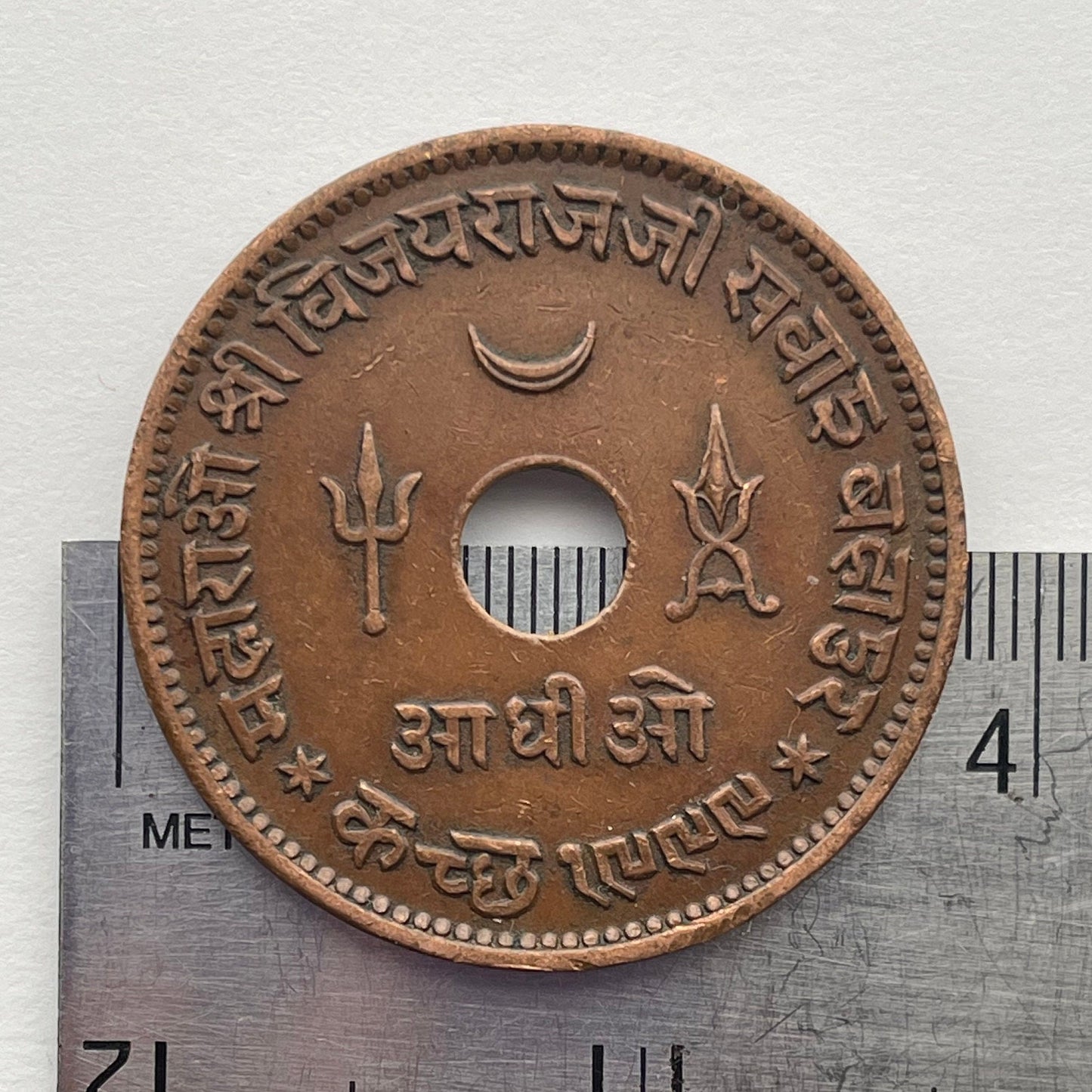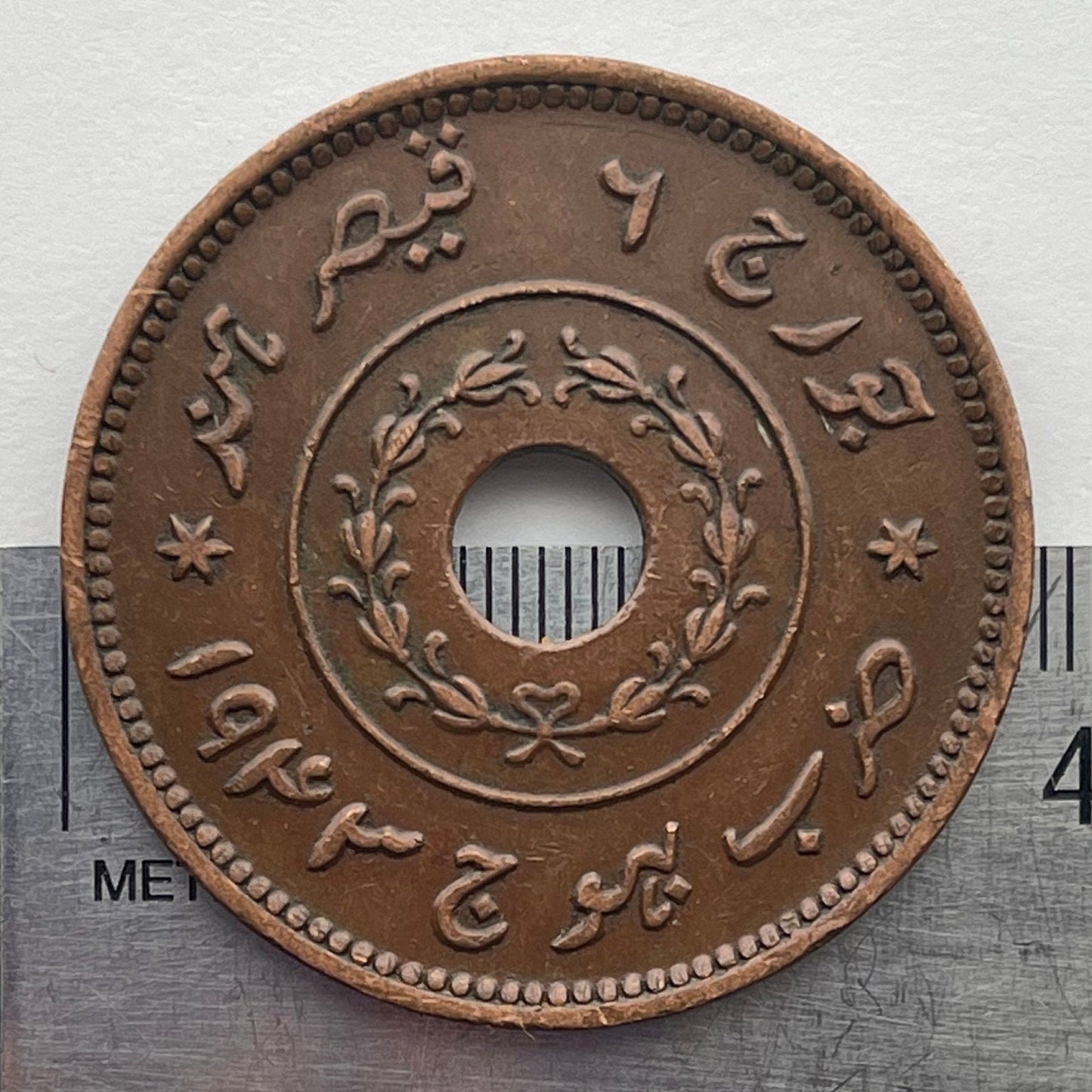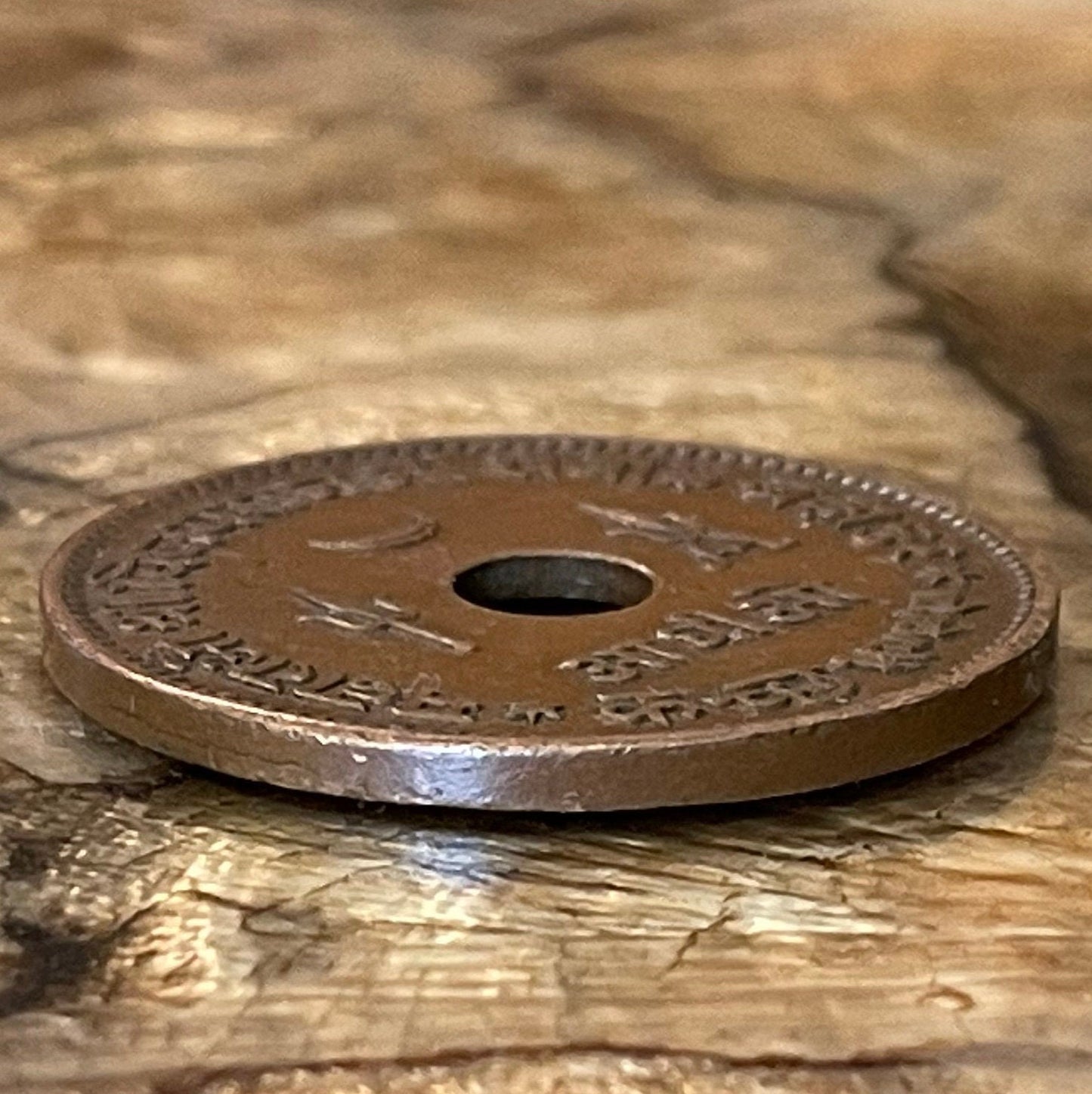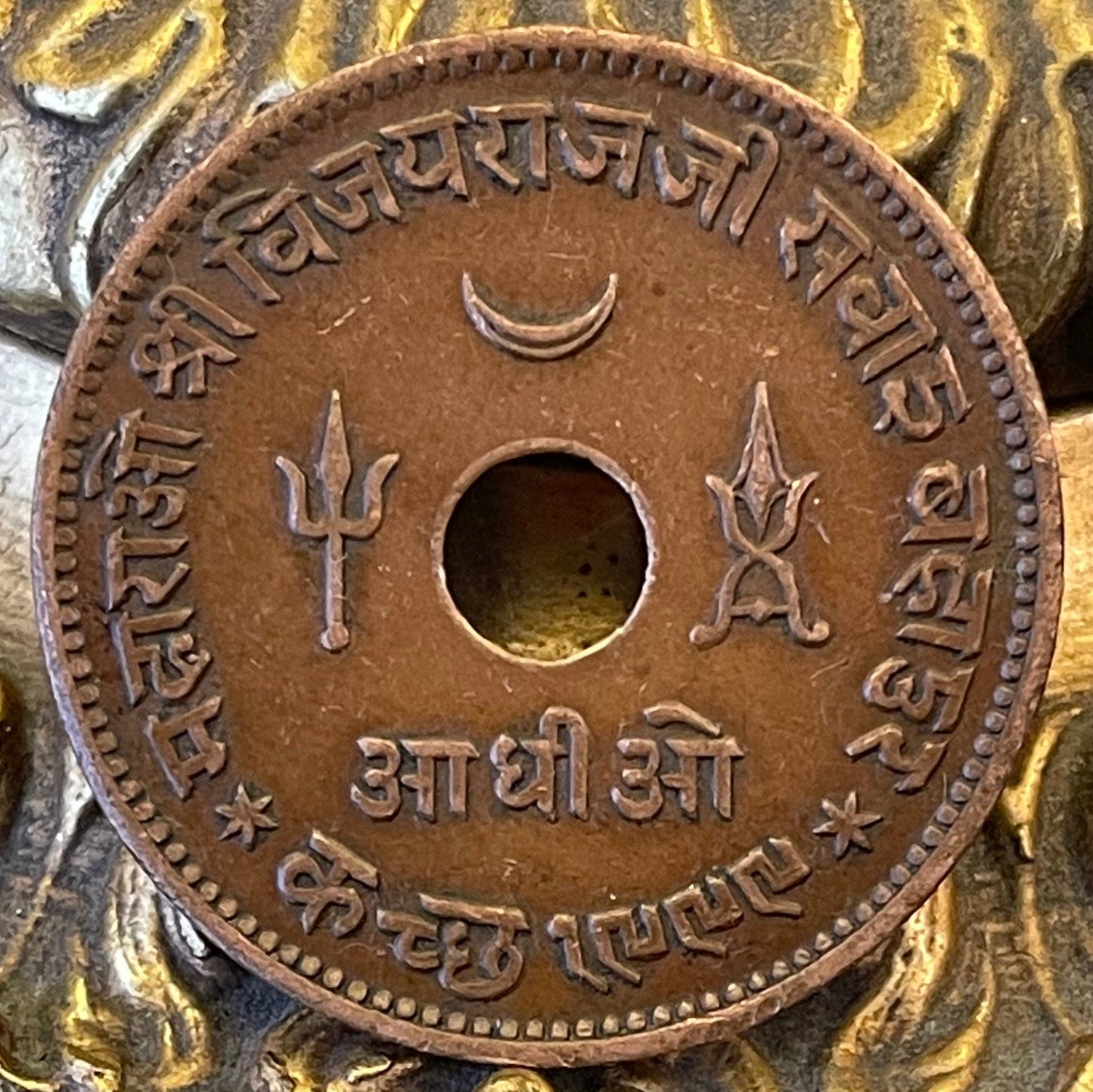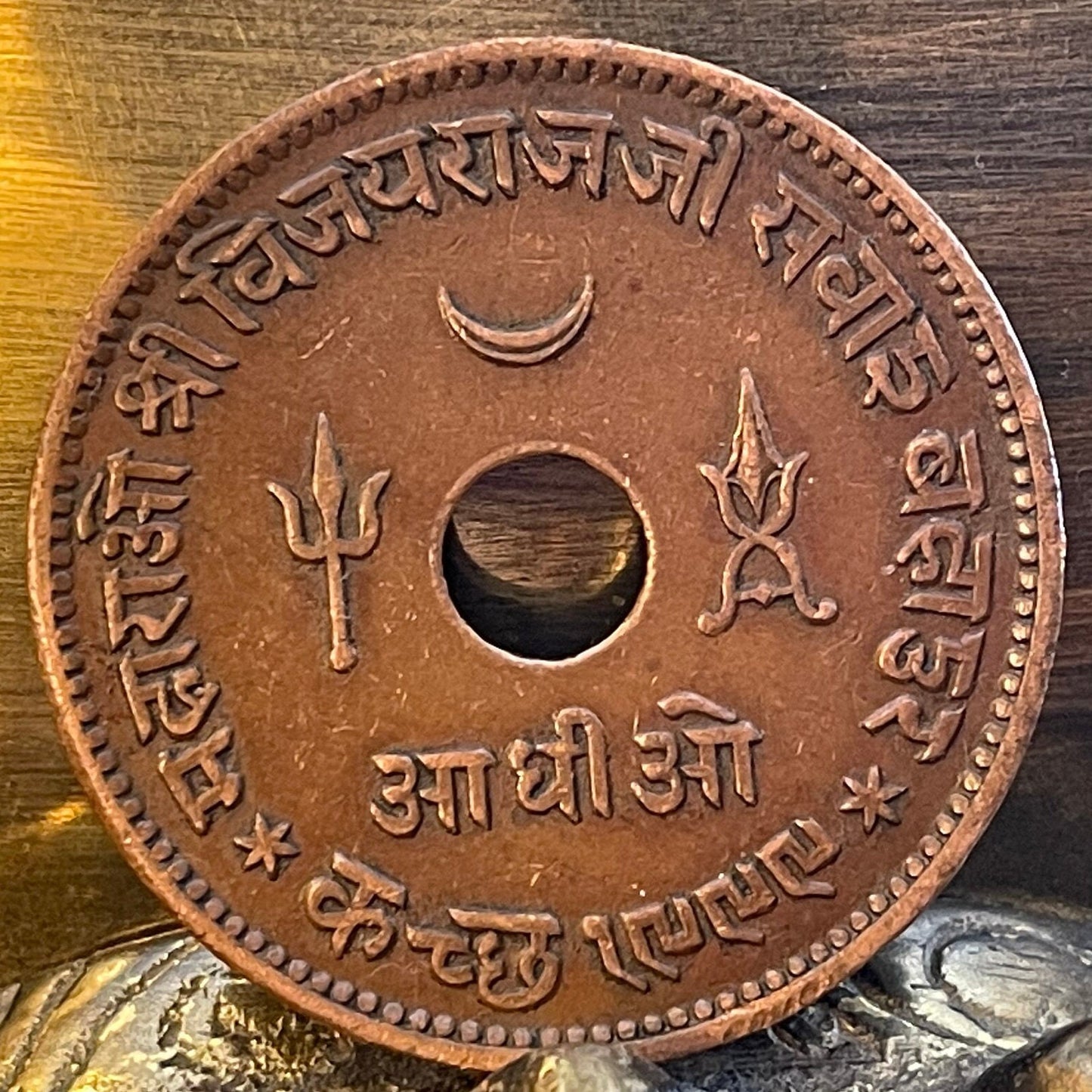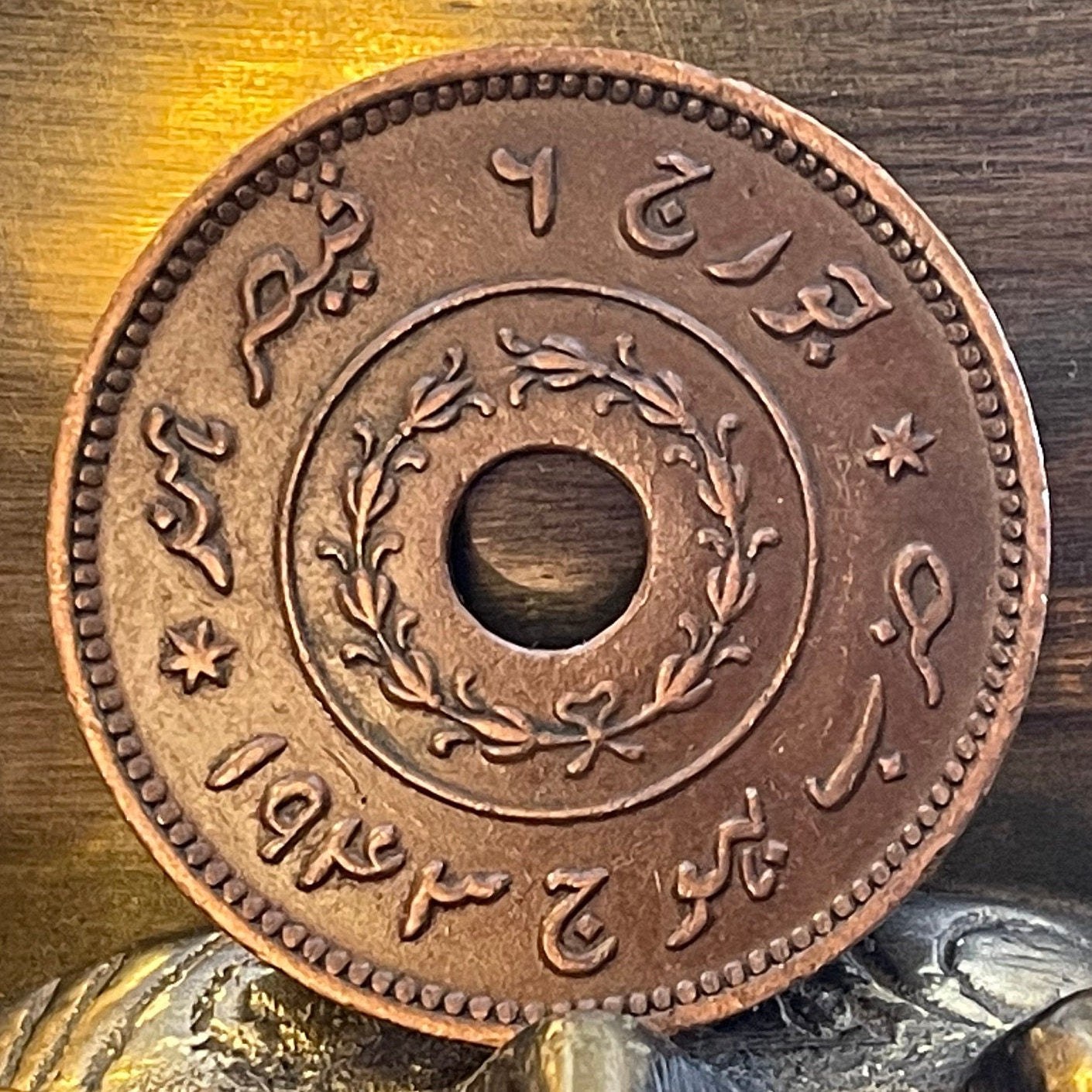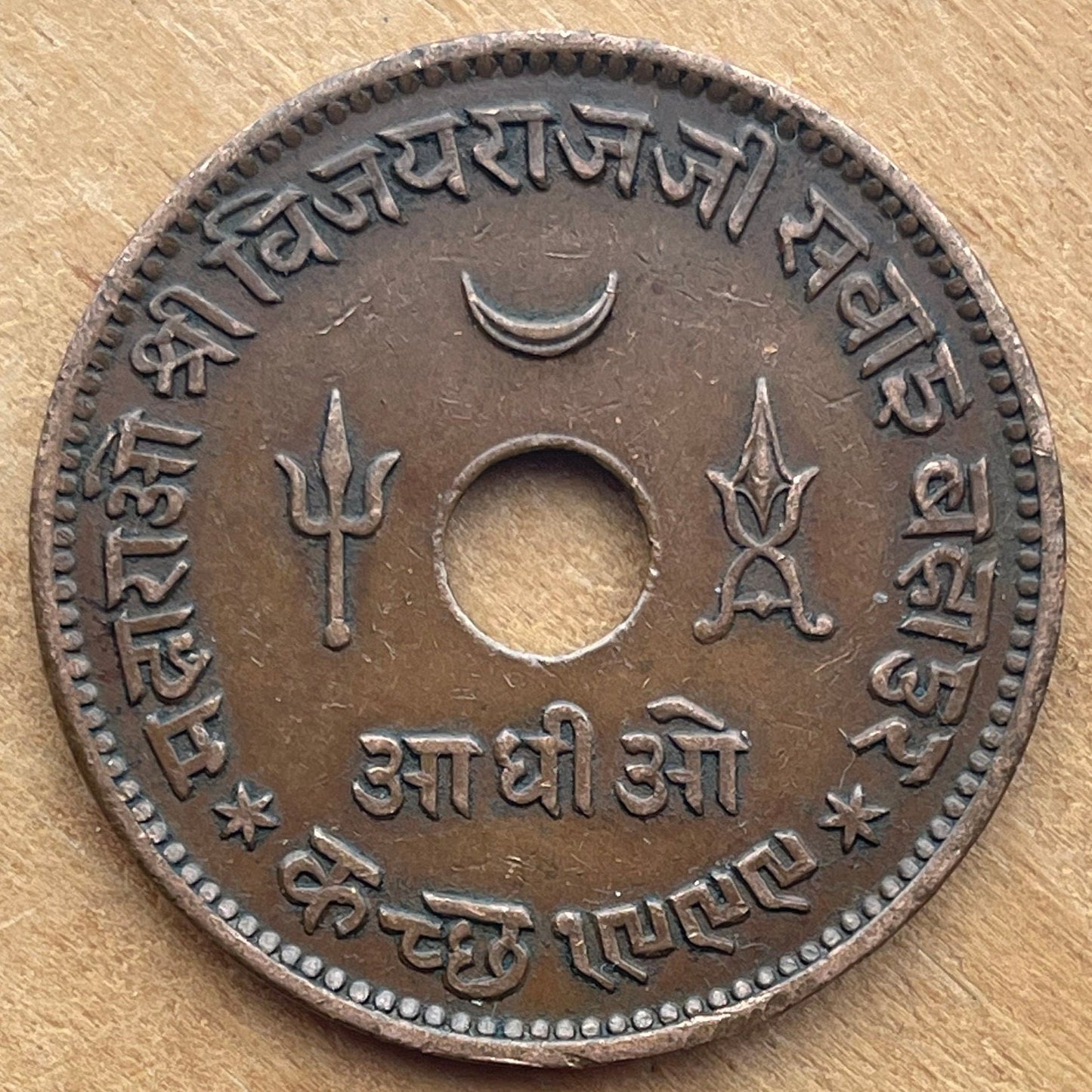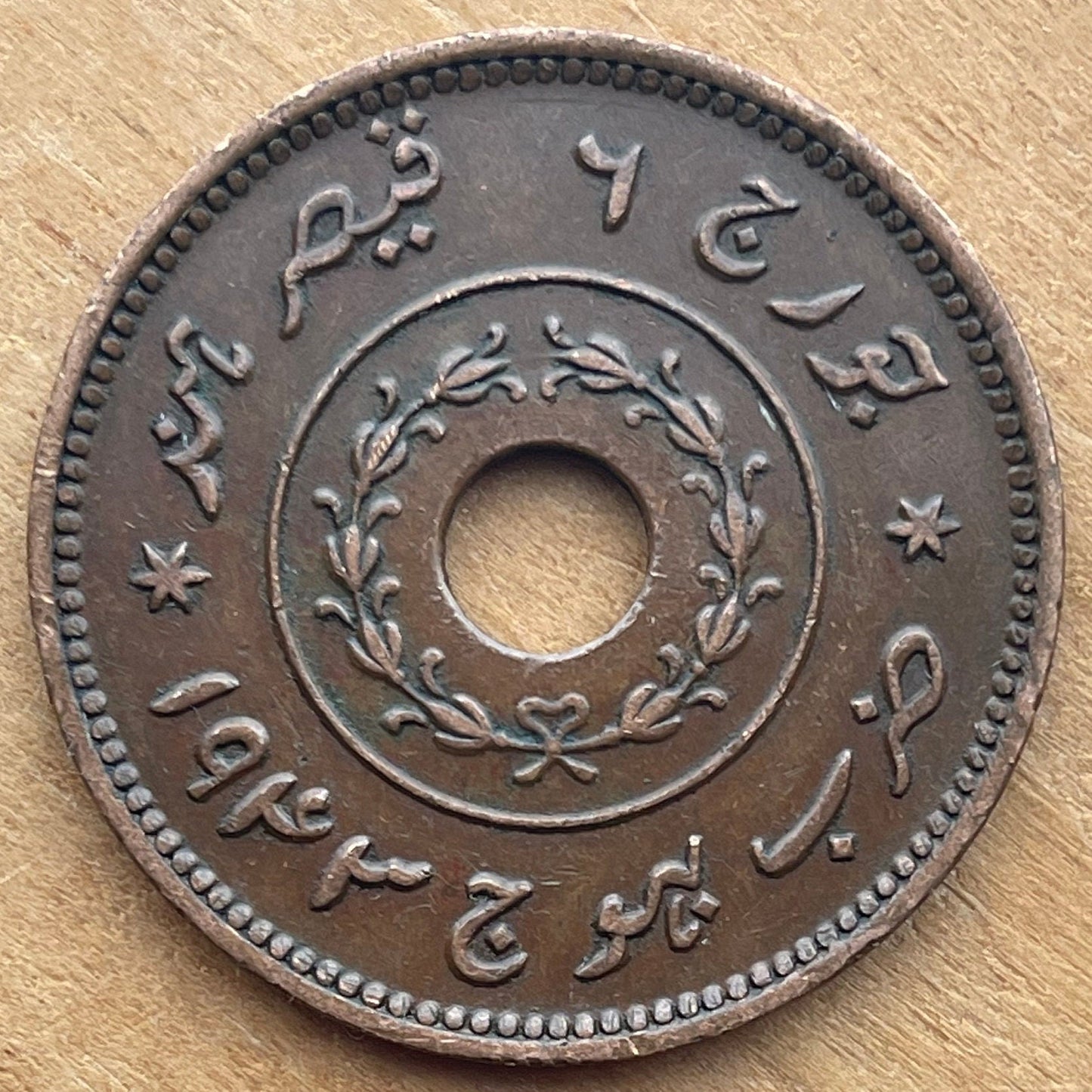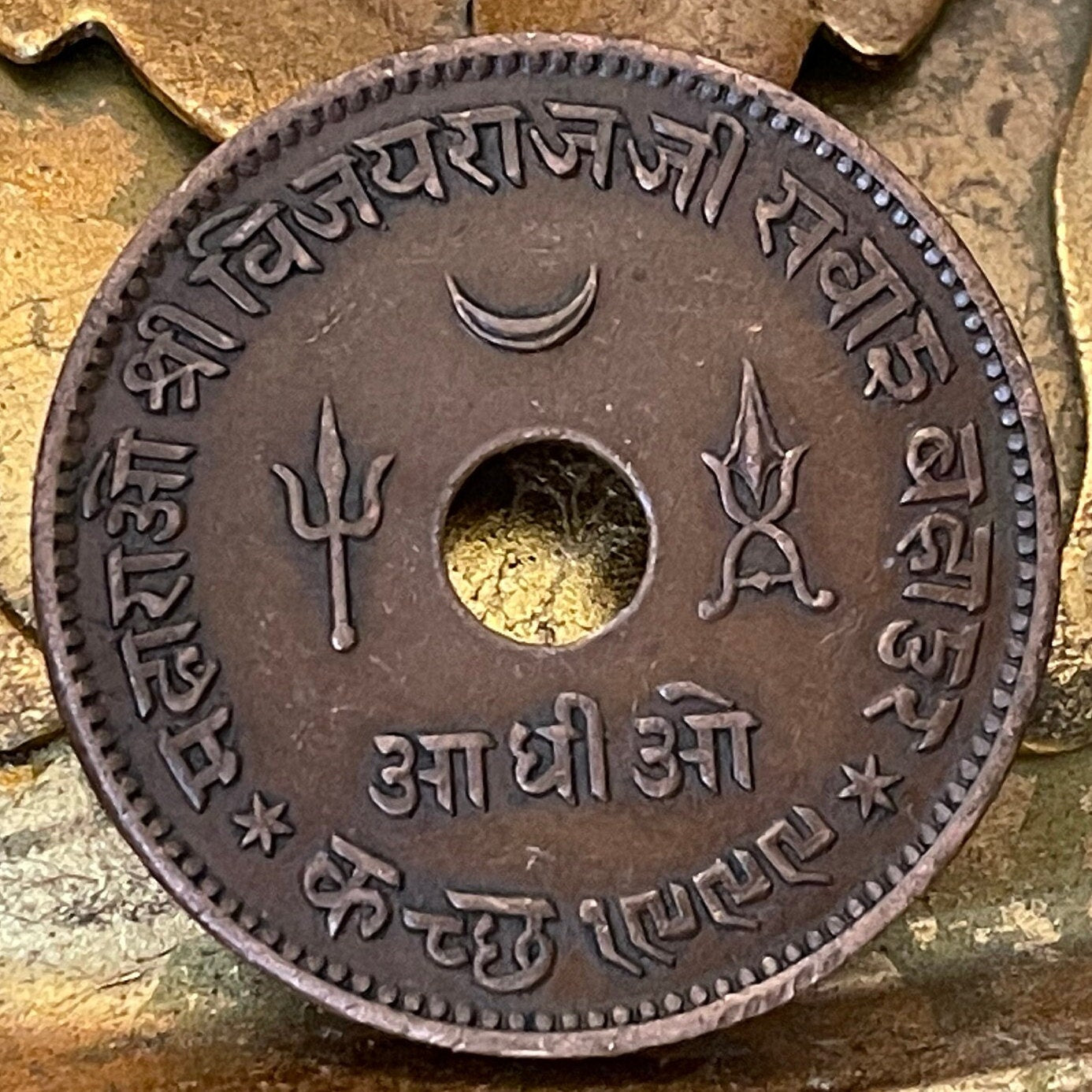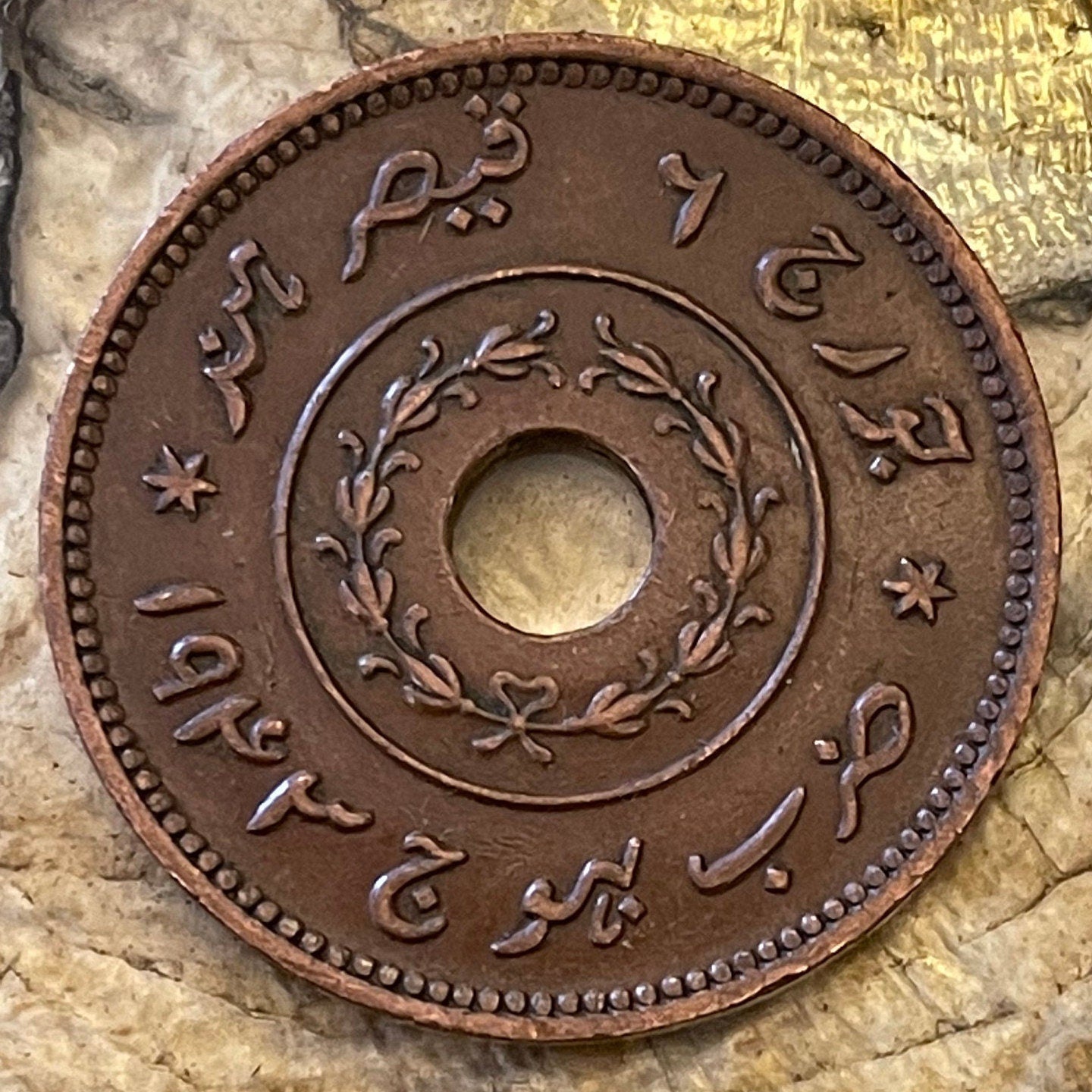elemintalshop
Trident Trishula, Lunar Crescent, Katar Dagger 1 Adhio India Princely State of Kutch Authentic Coin Money for Jewelry (Maharaja) (Hole Coin)
Trident Trishula, Lunar Crescent, Katar Dagger 1 Adhio India Princely State of Kutch Authentic Coin Money for Jewelry (Maharaja) (Hole Coin)
Couldn't load pickup availability
Trident Trishula, Lunar Crescent, Katar Dagger 1 Adhio India Princely State of Kutch Authentic Coin Money for Jewelry and Craft Making (Hole in Coin) (Maharaja Vijayarajaji) (George VI) (Emperor of India) (British Raj)
Obverse
Trishula Trident, Lunar Crescent, and Katar Dagger
Devanagari Lettering: महाराओ श्री विजयराजजी सवाइ बहादुर
आधीओ
कच्छ १૯૯૯
Translation: Maharao Shri Vijayarajaji Sawai Bahadur
Adhio
Kutch 1999
[N.B. This date is in the Vikram Samvat date system, and it corresponds to AD 1943. The lunisolar Vikram Samvat calendar is 56.7 years ahead of the solar Gregorian calendar; the year 2079 BS begins mid-April 2022 CE, and ends mid-April 2023 CE.]
Reverse: In center around hole, wreath inside plain circle
Outer margin, legend in Urdu Lettering:
★جورج ۶ قيصر ہند | ★۱۹۴۳ ضرب بہوج
Literally: George VI, Kaiser Hind, zarb Bhuj', AD date
English translation: George VI, Emperor of India, struck in Bhuj, 1943
[Bhuj, a city in northwestern Gujarat state, in west-central India, is situated in the lowlands between the Rann (marsh) and the Gulf of Kachchh (Kutch).]
Features
Issuer Princely state of Kutch (India - Princely states)
Type Standard circulation coin
Years 1943-1946
Value 1 Adhio (1/2 INK)
Currency Kori (1586-1947)
Composition Copper
Weight 16.5 g
Diameter 36.5 mm
Shape Round with a round hole
Technique Milled
Orientation Medal alignment ↑↑
Demonetized Yes
Number N# 42566
References Y# 80
******
Wikipedia:
Trishula (Sanskrit: triśūla) is a trident, a divine symbol, commonly used as one of the principal symbols in Hinduism. In India and Thailand, the term also often refers to a short-handled weapon which may be mounted on a daṇḍa "staff". Unlike the Okinawan sai, the trishula is often bladed.
The trishula symbolism is polyvalent and rich. It is wielded by the god Shiva and is said to have been used to sever the original head of Ganesha. Durga also holds a trishula, as one of her many weapons. The three points have various meanings and significance, and, common to the Sanatana Dharma, have many stories behind them. They are commonly said to represent various trinities—creation, maintenance, and destruction; past, present, and future; body, mind and atman; dharma or dhamma (law and order), bliss/mutual enjoyment and emanation/created bodies; compassion, joy and love; spiritual, psychic and relative; happiness, comfort and boredom; pride, repute and egotism; clarity, knowledge and wisdom; heaven, mind and earth; soul, fire and earth; soul, passion and embodied-soul; logic, passion and faith; prayer, manifestation and sublime; insight, serenity and Bodhisattvahood or Arhatship (anti-conceit); practice, understanding and wisdom; death, ascension and resurrection; creation, order and destruction; the three gunas: satva, rajas and tamas.
*******
Wikipedia:
The katar is a type of push dagger from the Indian subcontinent. The weapon is characterized by its H-shaped horizontal hand grip which results in the blade sitting above the user's knuckles. Unique to the Indian subcontinent, it is the most famous and characteristic of Indian daggers. Ceremonial katars were also used in worship.
*******
The crescent moon, in the Kutch symbology:
"The crescent, symbol of the family of the moon-dynasty."
https://www.crwflags.com/fotw/flags/in-kutch.html
WIkipedia:
The Lunar dynasty (IAST: Candravaṃśa or Somavaṃśa in Sanskrit) is a legendary principal house of the Kshatriyas varna, or warrior–ruling caste mentioned in the ancient Indian texts. This legendary dynasty was said to be descended from moon-related deities (Soma or Lunar). The Hindu deity Krishna is believed to be born in the Yaduvansh branch of the Lunar dynasty.
*****
Wikipedia:
Cutch, also spelled Kutch or Kachchh also historically known as Kingdom of Kutch, was a kingdom in the Kutch region from 1147 to 1819 and a princely state under British rule from 1819 to 1947. Its territories covered the present day Kutch region of Gujarat north of the Gulf of Kutch. Bordered by Sindh in the north, Cutch State was one of the few princely states with a coastline.
The state had an area of 7,616 square miles (19,725 km2) and a population estimated at 488,022 in 1901. During the British Raj, the state was part of the Cutch Agency and later the Western India States Agency within the Bombay Presidency. The rulers maintained an army of 354 cavalry, 1,412 infantry and 164 guns.
Cutch's flag was a red rectangular with images of a white elephant and Bhujia Fort in the centre and the word BHOOJ inscribed above the fort in white. The motto: Courage and Confidence was written below in a white ribbon.
********
Wikipedia:
Maharajadhiraj Mirza Maharao Sri Sir Vijayarajaji Khengarji Sawai Bahadur, GBE (2 September 1885 – 26 February 1948) was the ruling Rao of Cutch from 1942 to his death in 1948.
As Yuvraj, Sir Vijayarajaji worked closely with his father, Khengarji III, and often was left to administer the state during his father's frequent journeys abroad.
He built upon his father's reforms, instituting the Kutch High Court, elected village councils and greatly expanded irrigation works and agricultural development in the state during short span of six years of his rule. He took keen interest in irrigation projects and took advice of experts for the matter and it was during his reign the famous Vijaysagar reservoir was built with an irrigation capacity of almost 4047 hectors. A total of 22 dams, mostly earthen, were constructed during his reign of six years, which even today stand to test of time. Also in his reign Cutch became the third princely state after Hyderabad and Travancore to start its own bus transport services beginning in year 1945. Sir Vijayrajaji was a botanist and ornithologist. In years 1942–45, he funded and facilitated Salim Ali's survey of the birds of Kutch.
In year 1947, upon advice of Mahatma Gandhi, 15,000 acres (61 km2) of land was donated by Shri Vijayrajji for re-settlement of refugee Hindu Sindhi community, who had migrated across the border into Kutch from Sindh area of Pakistan upon partition of India. The towns of Gandhidham and Adipur were developed on this land donated by him.
He acceded the Princely State of Cutch to the Dominion of India on 16 August 1947, which thus became the first princely state to accede into India. As he was in London at the time India gained independence, he took a decision from there only and the Instrument of Accession of Kutch was signed on his behalf by his heir & son Meghraji, on his behalf. He died on 26 January 1948, aged 62 and was succeeded by his eldest son and Yuvraj, Meghraji.
*********
Wikipedia:
George VI (Albert Frederick Arthur George; 14 December 1895 – 6 February 1952) was King of the United Kingdom and the Dominions of the British Commonwealth from 11 December 1936 until his death in 1952. He was concurrently the last Emperor of India until August 1947, when the British Raj was dissolved.
Known as "Bertie" among his family and close friends, George VI was born in the reign of his great-grandmother Queen Victoria and was named after his great-grandfather Albert, Prince Consort. As the second son of King George V, he was not expected to inherit the throne and spent his early life in the shadow of his elder brother, Edward. He attended naval college as a teenager and served in the Royal Navy and Royal Air Force during the First World War. In 1920, he was made Duke of York. He married Lady Elizabeth Bowes-Lyon in 1923, and they had two daughters, Elizabeth and Margaret. In the mid-1920s, he had speech therapy for a stammer, which he learned to manage to some degree. George's elder brother ascended the throne as Edward VIII after their father died in 1936. Later that year, Edward abdicated to marry the twice-divorced American socialite Wallis Simpson, and George became the third monarch of the House of Windsor.
In September 1939, the British Empire and Commonwealth—but not Ireland—declared war on Nazi Germany. War with the Kingdom of Italy and the Empire of Japan followed in 1940 and 1941, respectively. George was seen as sharing the hardships of the common people and his popularity soared. Buckingham Palace was bombed during the Blitz while the King and Queen were there, and his younger brother, the Duke of Kent, was killed on active service. George became known as a symbol of British determination to win the war. Britain and its allies were victorious in 1945, but the British Empire declined. Ireland had largely broken away, followed by independence of India and Pakistan in 1947. George relinquished the title of Emperor of India in June 1948 and instead adopted the new title of Head of the Commonwealth. He was beset by smoking-related health problems in the later years of his reign and died of coronary thrombosis in 1952. He was succeeded by his daughter, Elizabeth II.
Share
